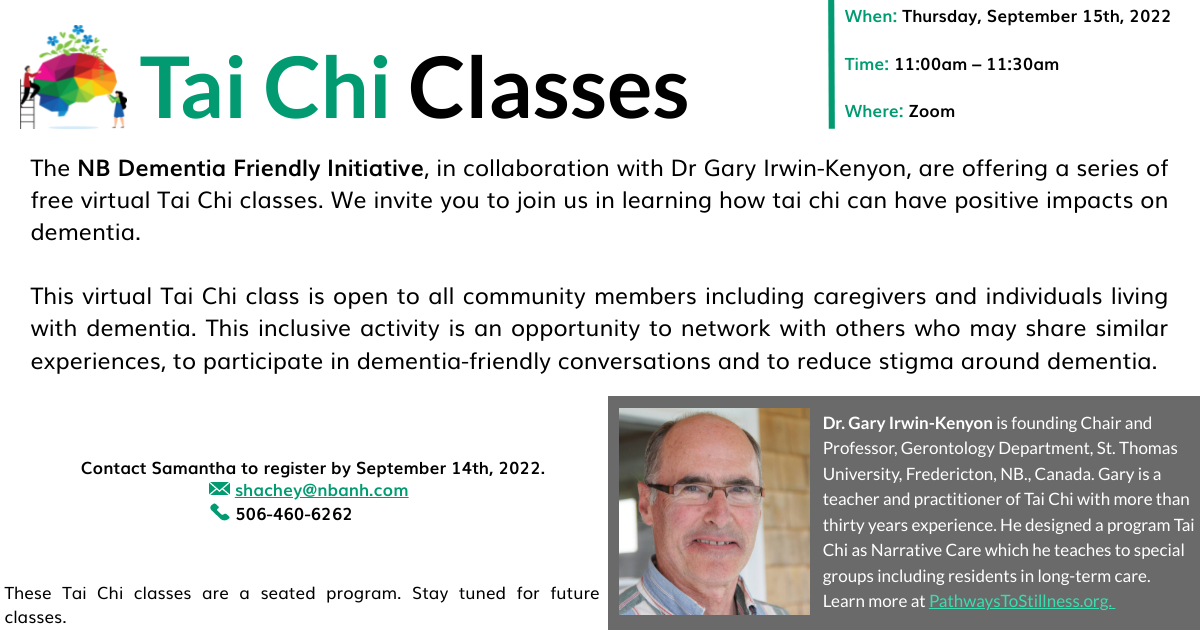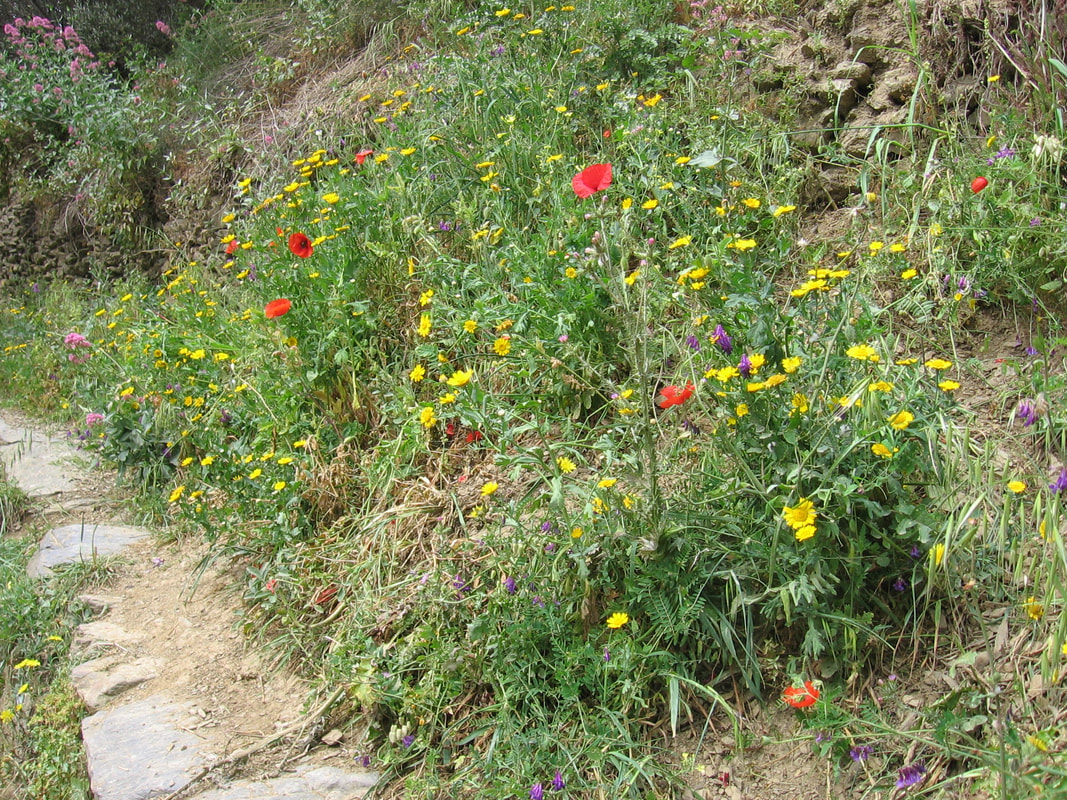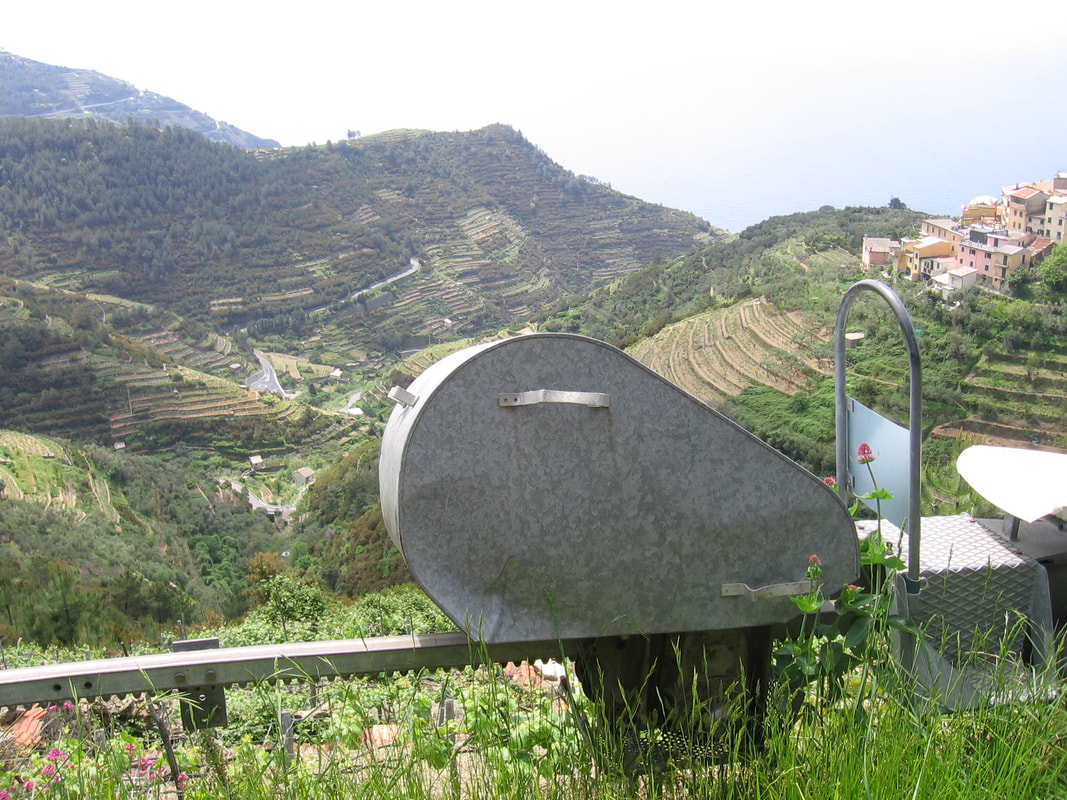|
Dr. Gary Irwin-Kenyon, Tai Chi instructor and author of "Pathways to Stillness", sits down with CHCO's Vicki Hogarth to talk about the importance of finding calm and stillness, and how anyone can use the art of Tai Chi to practice mindfulness in an often busy and hectic life. Southwest Magazine is an original CHCO Television production taped on location at the CHCO-TV studio in Saint Andrews, New Brunswick, Canada.
0 Comments
 Register now to attend a unique continuing education course to train therapeutic activity professionals in long-term care to guide seated tai chi sessions for people in their care. Course Summary Tai Chi can bring us to a quiet center in our being. It is as though our ailments disappear during the Tai Chi session. While the movements you learn are significant in this process, creating a stillness environment is equally crucial. During the course, you will learn how to guide seated Tai Chi sessions for people in your care. Prior knowledge of Tai Chi is not needed. Ideally, your main commitment is to practice the movements yourself every day from the point at which to start the course. With practice, both you and the people who participate in the seated Tai Chi sessions will experience less anxiety, increased relaxation, and feelings of well-being. This course is $549.00 + HST. In New Brunswick, 50% is reimbursed through workplace training grants. We can support your organization to apply for the grant.
 Click here to Listen on Apple Podcasts Click here to Listen on Apple Podcasts Imagine if through the practice of stillness, we could unlock a deeper sense of calm and peace, not just for ourselves, but also for people living with dementia. Professor Dr. Gary Irwin-Kenyon, our special guest for today, shares his incredible journey finding tranquility through martial arts and Tai Chi, and how these methods can bring profound benefits to those with dementia and their care partners. We take a deep dive into the fascinating world of stillness and its immense potential in dementia care. Tai Chi class - 20 minutes to relaxation and stillness practice Hosted by Samantha Hachey, New Brunswick Association of Nursing Homes. In this conversation, Rahzeb Choudhury, founder of Lifelong Inspiration, was joined by Dr. Gary Irwin-Kenyon, Author, Tai Chi Teacher and Gerontologist. This conversation is part of The Best Eldercare, articles and videos bringing together experts from around the world to share their knowledge and ideas to help educate us all on their area of specialisation. I talk to care professionals, researchers, people with lived experience, and entrepreneurs. The focus is person-centred care, human-centred design and human rights-based approaches. There is a Taoist story of an old farmer who had worked his crops for many years. One day his horse ran away. Upon hearing the news, his neighbors came to visit. "Such bad luck," they said sympathetically. "May be," the farmer replied.
The next morning the horse returned, bringing with it three other wild horses. "How wonderful," the neighbors exclaimed. "May be," replied the old man. The following day, his son tried to ride one of the untamed horses, was thrown, and broke his leg. The neighbors again came to offer their sympathy on his misfortune. "May be," answered the farmer. The day after, military officials came to the village to draft young men into the army. Seeing that the son's leg was broken, they passed him by. The neighbors congratulated the farmer on how well things had turned out. "May be," said the farmer. . .It takes courage to let go. More often it seems that you let go out of exhaustion or desperation; you feel you have tried everything else—including positive thinking. Eckhart Tolle says that most of us are dragged, kicking and screaming, to enlightenment. I believe what he means here is that we are all in stillness anyway, but until we learn to be better at letting go, our journey to stillness can be rough. From this point of view, when things happen to you that you experience as loss and suffering, you are in fact being given an opportunity to connect with your stillness, and, in the end to be free of suffering. I hardly need to add that this is easier said than done. Nevertheless, the process of relaxing into stillness and exploring your pathway is designed precisely to help you on this journey to life, by responding to your suffering in a kinder and gentler way. (From Chapter 5 in Pathways to Stillness: Relax, Release, Renew).
,In a stillness or mindfulness approach to suffering and loss, in contrast to positive thinking, you do not split yourself between what you accept as "you" and what you do not want to accept. It is all you—the stillness and the area of suffering. For example, one of my Dutch colleagues works with people who suffer from depression. His clients first say "I am a depressed person". He tries to help them move to a different story: "I am a person who is experiencing depression". In this way there is less danger for the pain part of your story to take you over and run the show—the pain story gets placed into a larger story of who you are. At this point, there is the possibility that your ordinary wisdom can emerge and help you find meaning, peace, and stillness—even in your suffering. Notice that in this approach you are not trying to DO anything or get anywhere in particular— like find a positive answer to your problem. You are accepting and letting go, but not letting go into nothing, but into stillness—a comforting presence.
A stillness approach to restorying your life is helpful because you are hoping to change your entire story which includes how you think, feel, and act. Researchers who work with lifestories—what is also called narrative research--have discovered that any change that occurs in one part of your life affects your entire life. This is true for chronic pain, widowhood, stroke, dementia, terminal illness, disability and many other changes.Increasingly, stillness approaches are being used in substance abuse programmes, as they have the potential to help addicts to step outside the vortex of their addiction story by creating a space between their thoughts of using and their sensations and actions. In this way, you feel better about things by first giving yourself a break and connecting with your stillness (to be continued).
In contrast to the effort to engage in positive thinking with a focus on controlling or fixing a particular life challenge, which comes from your Doing mode, a stillness approach such as restorying, suggests that you first get out of your thinking mind, step back, enter your Being mode and try to see the larger picture. In this way, instead of fighting or denying the change that has occurred in your life, you make room in your present story for the change that has occurred, or that you want to occur. It is about finding new meaning in your whole story, not just attempting to fix the broken part. While there are no guarantees, lasting change and stillness are more likely to occur in your life by following this approach (to be continued).
Your life as a story is made up of thoughts, emotions, and actions or behaviour—that is how you think, feel, and act. It may be possible to change your thoughts about something, and there are techniques to help you try this approach. Yes, positive thinking is one of these techniques. However, the effort it takes to maintain this attitude may become exhausting, as with such challenges as chronic pain, grief, or addiction.The problem is that you are still attempting to control or fix the problem, as your thinking mind scrambles around to find a positive solution. This can be a prison in the sense that you are either a winner or a loser, depending on how successful you are in keeping up the program. .So you are suffering from the life challenge and then you suffer more if your willpower is not sufficient to think positively. (to be continued).
You grow, learn, and find meaning, ordinary wisdom, and stillness through stillness practice and through your lifestory. However, the restorying journey does not involve simply choosing a better story to replace the old one. Also, new meaning does not come from forcing yourself to think positively about a troublesome situation. In fact I agree with the statement that positive thinking can become a prison. (To be Continued)
Tai Chi philosophy tells us that human life itself is yang energy, meaning that it is a stressor.Tai Chi is yin energy because it attempts to balance that stressor by receiving, accepting, and neutralizing. Tai Chi involves a giving-in but by no means does it involve a giving up. It is not resignation but acceptance, which means that you attempt to follow the situation until it can be brought to a balanced conclusion. You try not to interfere with the momentum of the force, whether physical or emotional. In other words do not push the river. (read more in my book Pathways to Stillness: Reflect, Release, Renew).
. This video is part of the Memory Vault of virtual activities for the IG Wealth Management Walk for Alzheimer’s. If you would like to help unlock more videos and activities, click here to sign up for the IG Wealth Management Walk for Alzheimer’s. Funds raised support people impacted by dementia in YOUR community! Thank you Dr. Kenyon for supporting this important cause In this episode I talk with Ashley and Daphne about the services and programmes Person Centred Universe offers their clients and the community.
It is such a pleasure to be in conversation with two former students about their dementia support and education company. Daphne and Ashley share the story of the beginnings of their vision for transforming dementia care and how the journey evolved from university days to becoming entrepreneurs in the health care world.
|
Pathways to Stillness BlogMy Blog is about how you can discover your own Pathways to Stillness, and why that is so valuable to your life. We will explore what it means to lose and regain our sense of “our story” in the midst and aftermath of loss—negative beliefs about aging and how we can make them more positive, and the many benefits reaped by creating a refuge of stillness within.
January 2024
Categories |













 RSS Feed
RSS Feed




